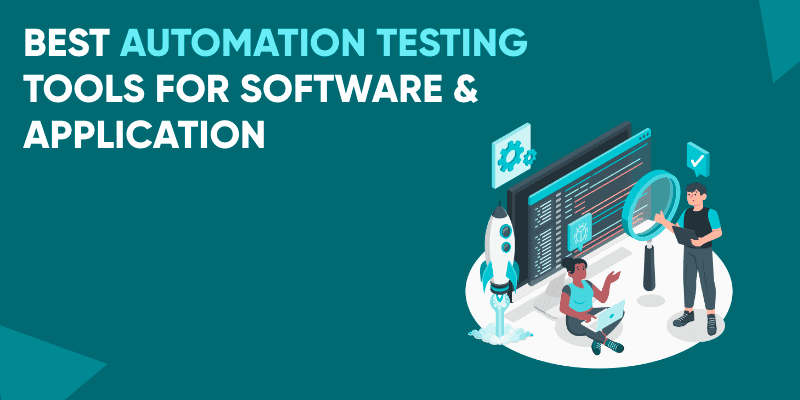The Ultimate Guide to Automation Testing Tools in 2025: Powering Smarter Mobile and Web Apps
In 2025, automation testing is no longer optional—it’s essential. As businesses across industries push for faster, more reliable mobile app deployments, the demand for intelligent, scalable testing tools is surging. Whether you’re developing Android apps, iOS apps, or complex cross-platform solutions, automation testing tools help ensure software quality, speed, and user satisfaction. This guide explores the top trends, tools, and strategies redefining quality assurance for modern mobile and web applications.
Why Automation Testing Matters More Than Ever
In today’s fast-paced digital landscape, mobile and web apps must be continuously updated to meet user expectations. Manual testing simply can’t keep up. Automation testing tools empower QA teams to test smarter and faster, enabling:
Continuous integration and delivery (CI/CD)
Faster release cycles for Android and iOS apps
Greater testing accuracy and coverage
Reduced human error and resource costs
Improved user experience through consistent functionality
By adopting automation early, businesses can shift-left and shift-right—catching issues at every stage of development and maintaining product reliability after release.
2025 Testing Trends You Can’t Ignore
1. AI-Powered Test Automation
Artificial Intelligence is transforming how test cases are written, maintained, and executed. Tools now use machine learning to auto-generate test scripts, detect bugs, and self-heal broken tests—boosting accuracy while reducing manual effort.
2. Low-Code & No-Code Testing Platforms
In 2025, more QA teams are leveraging low-code testing tools to create complex workflows without writing a single line of code. These platforms enable cross-functional teams—including non-developers—to participate in mobile and web app testing.
3. Cloud-Based Testing Environments
Cloud testing tools provide instant access to real devices and browsers, eliminating the need for in-house device labs. This enables scalable Android and iOS app testing on thousands of device combinations in real time.
4. TestOps and Hyperautomation
TestOps integrates testing into DevOps pipelines, supporting automation at every step—from development to production monitoring. Combined with hyperautomation, teams can now automate repetitive tasks, test data management, and even analytics.
5. Shift-Left & Shift-Right Strategies
Smart companies now test earlier in development (shift-left) and continue validating performance in production (shift-right). This dual approach ensures higher test coverage and real-world stability.
Must-Have Features in Modern Automation Tools
If you’re building or testing Android, iOS, or hybrid mobile apps in 2025, here are the key features your automation tool should offer:
Cross-platform support (Android, iOS, Web)
AI-driven test generation and maintenance
Integration with CI/CD pipelines (Jenkins, GitHub Actions, GitLab)
Real device and browser testing via the cloud
API, UI, and performance testing capabilities
Visual testing and regression tracking
Data-driven testing with dynamic input handling
Mobile-friendly test reports and analytics dashboards
Top Automation Testing Tools for 2025
Appium – Ideal for native, hybrid, and mobile web apps across Android and iOS. Open-source and widely supported.
Selenium – A staple for cross-browser testing, best for web applications.
Playwright – Fast and reliable for modern web automation with full cross-browser support.
Katalon Studio – Combines low-code interface with advanced features for mobile, web, and API testing.
Cypress – Great for JavaScript-based web app testing with fast feedback loops.
Testsigma – A cloud-native, no-code automation tool suitable for mobile and web apps.
TestComplete – Enterprise-grade automation supporting desktop, mobile, and web with record-and-playback.
Tricentis Tosca – Ideal for large-scale enterprise testing with model-based automation.
Ranorex – Strong for cross-platform GUI testing, especially desktop apps.
BrowserStack – Cloud-based platform for real-time device and browser testing.
How to Build a Winning Test Automation Strategy
1. Define Goals and Platforms
Start by identifying your target platforms—Android, iOS, or both. Choose tools that offer cross-platform compatibility and flexibility.
2. Automate Test Suites Early
Begin automation in the early stages of app development. Integrate unit, functional, UI, and regression testing into your CI/CD pipelines.
3. Leverage Real Devices
Emulators are great for initial testing, but real-device testing ensures accuracy. Use cloud-based device labs to validate performance on actual hardware.
4. Use Data-Driven Testing
Feed tests with dynamic inputs to simulate real-world use cases. This improves test accuracy and identifies edge cases.
5. Continuously Monitor and Optimize
Monitor your apps post-release with shift-right practices. Capture crash logs, user behavior, and system errors to improve over time.
Benefits of Automation Testing for Android & iOS Apps
Faster app launches with reduced testing time
Improved stability and user satisfaction
Better test coverage across devices and operating systems
Reduced QA costs through reusable test scripts
Streamlined updates with minimal manual intervention
Early bug detection that prevents costly rollbacks
Enhanced scalability for growing mobile products
Final Thoughts: QA as a Growth Engine in 2025
Quality Assurance is no longer a behind-the-scenes task—it’s a business-critical function. In 2025, automation testing tools empower teams to release better mobile apps, faster and with greater confidence. By adopting modern test automation strategies, leveraging AI and cloud platforms, and aligning with the latest mobile trends, businesses can ensure that every Android and iOS app they release performs flawlessly.
If your goal is to stay ahead in the competitive digital space, now is the time to embrace intelligent, mobile-friendly automation tools that improve user experience, drive retention, and support business growth.
In this article, we’ve compiled a comprehensive list of automation testing tools for your convenience. You can explore each option and determine which is best for your project.
Running software programs that automatically execute test cases and create test results without the need for human intervention is known as automation testing.
It’s an improvement above manual testing. It saves a lot of energy and resources while leaving little or no opportunity for error. You can run these tests as many times as you need to analyze the same application once they’re ready, cutting down on manual testing time.
Because of the growing necessity and desire for automation in IT, a variety of top automation testing technologies are now available.
In the list below, we’ve included both commercial and open-source test automation options. Almost all licensed products, on the other hand, include a free trial version that allows you to check out the tools before deciding which one is best for you.
So, let’s start with the best automation tools available to help you with your testing!
Why And How To Choose The Right Automation Testing Tools?
There are currently a plethora of automation testing tools available, and new ones appear every year. Some are open-source and free, while others demand a fee based on the functionality they provide.
Some of these automation tools have been around for a long time, while others are brand new and untrustworthy. Each of these tools, however, is unique and has its own set of characteristics.
And, with so many test automation tools to pick from, it’s difficult to choose the right one for your project, and testers frequently end up with tools that don’t satisfy project requirements. As a result, choosing the appropriate automated testing tools for your project is crucial.
What Are Automation Testing Tools?
The software that allows you to construct testing activities and then automate the testing process is known as automated testing tools. This would happen in a perfect world with very little human influence.
Automation testing methods are available for smartphones, mobile devices, and desktop computers, among other platforms. Testing automation enables performance testing to take place without the need for human intervention, allowing code to be tested 24 hours a day if necessary and speeding up the test execution process.
Automation testing solutions, on the other hand, are capable of much more and provide benefits such as increased test coverage, faster time to market, uniformity in software testing, and so on.
Now, let’s look at why it’s important to choose the correct automated testing tools and how to do it.
Here are some simple tips for determining which tool is best for your project:
- Select the tests to automate.
- Analyze and evaluate the automation choices that best meet your automation needs and budget.
- Based on the needs, choose the two most appropriate tools
- Conduct a comparison test between two of the best tools and determine the winner.
- Other stakeholders should know about the automation tools, and their consent is essential.
- Continue to automate your testing.
- On the market, there is no such thing as the best tool. Instead, you must choose the technology that is best suitable for your test automation project’s goals.
Katalon Studio
Katalon Studio is a low-code and scalable web, API, desktop (Windows), and mobile application automation testing tool. The Katalon community has now surpassed 1 million users, and it is the trusted automation solution of over 100,000 enterprises.
Users can simply download the tool and focus only on testing now that the prerequisites of coding and establishing a test automation framework have been removed. Studio also releases frequently to keep up with the latest platforms, browsers, and operating systems.
Feature Highlights:
- Record and Playback, Manual, and Scripting Mode are all flexible options for test design.
- BDD, DDT, Keyword-Driven Testing, Cross-Browser Testing (Headless, Chrome, Edge, Firefox, and Safari), and Cross-Platform Mobile Testing are all supported testing approaches (iOS, Android)
- Retrying Automatically Failed tests, smart waiting, and self-healing processes are all examples of self-healing systems.
- With Test Artifact Sharing and Page Object Model design, you may reuse test objects, keywords, and test cases.
- Popular CI/CD and ALMs tools have native integrations (Jira, GitLab, Jenkins, BitBucket, Azure DevOps, etc.)
- To swiftly debug errors, use the Smart Debugging UI and test reporting.
- Katalon Academy has detailed tool documentation and video lessons.
Price: Free or $76/month
Selenium
This framework, which was released in 2004, is one of the most popular open-source frameworks for web testing automation, if not the most popular. Selenium WebDriver, Selenium Grid, and Selenium IDE are part of its product suite.
Feature Highlights:
- Java, C#, Python, JavaScript, Ruby, PHP, and other programming languages are supported
- Browsers that are supported include Chrome, Firefox, Internet Explorer, Microsoft Edge, Opera, Safari, and others.
- Parallel and cross-browser executions to minimize execution time and boost test coverage
- Testing on local or on remote workstations using the Selenium server
- Integrations with other testing frameworks (such as TestNG for reporting) and continuous integration and delivery (CI/CD) technologies
Price: Free
Appium
This is an open-source automated testing tool for mobile applications, similar to Selenium. The framework allows customers to write automated UI tests for native, web-based, and hybrid mobile applications on Android and iOS using the mobile JSON wire interface.
Feature Highlights:
- Java, C#, Python, JavaScript, Ruby, PHP, and Perl are all supported programming languages.
- Cross-platform testing using the same APIs and reusable test scripts
- Implementation of real-world devices, simulators, and emulators
- Integrations with various testing frameworks and continuous integration and CD tools
Price: Free
TestComplete
This helps in automating Functional UI testing for desktop, mobile, and online applications. TestComplete can handle and identify dynamic UI elements in most available technologies, thanks to built-in support for 500+ controls and third-party frameworks.
Feature Highlights:
- JavaScript, Python, VBScript, JScript, Delphi, C++, and C# are all supported programming languages.
- Record and playback, manual and scripting modes with built-in keywords are all options for test design.
- Object recognition using AI visual recognition and property-based object identification
- Cross-browser and cross-device testing in parallel
- Integrations with various testing frameworks, CI/CD tools, and the SmartBear ecosystem
Price: From $2,702/year
Cypress
First, it is a developer-centric automation solution for end-to-end web testing that only supports JavaScript frameworks. Second, it is built on a unique architecture that allows it to run in the same run-loop as your application, allowing native access to elements and speedier execution.
Feature Highlights:
- JavaScript is a supported programming language.
- Screenshots of test step execution and debugging from well-known development tools
- Function behavior, server response, timing, and network traffic are all under your control.
- For test performance and optimization, connect to the Dashboard Service.
- Popular CI/CD tools are integrated.
Price: Free or from $75/month for Dashboard Service
Ranorex Studio
Ranorex Studio, which comes next on the list, can automate GUI testing for online, mobile, and desktop apps. Ranorex’s framework, which comes with both low-code automation and a full IDE, is simple to use for beginners and productive for experienced testers.
Feature Highlights:
- Supports VB.Net and C# are.
- Web, mobile, and desktop technologies are all well-supported.
- For reliable GUI element detection, use the Ranorex Spy tool and RanoreXPath.
- Record & Playback, as well as scripting mode, are two flexible approaches for test design.
- Selenium Grid allows for distributed or parallel testing.
- Integrations with other testing frameworks and CI/CD tools.
Price: From €2,890/year
Perfecto
This is a web and mobile application testing tool that is cloud-based and automated. Moreover, it makes continuous testing easier for DevOps teams with automated cross-environment executions, custom features, test analysis, and broad integrations.
Feature Highlights:
- Test development for UI web applications without the use of scripts
- Mobile testing with real-user stimulation: network visualization and other environmental circumstances
- Executions in parallel and across platforms
- AI noise filtering and advanced test analytics with a centralized dashboard
- Integrations with various testing frameworks and CI/CD tools
Price: From $125/month
LambdaTest
LambdaTest is a cloud-based testing service. Its cloud solution enables teams to expand their test coverage by performing parallel, cross-browser, and cross-device testing quickly.
Feature Highlights:
- Selenium Grid is a cloud-based Selenium testing platform with over 2000 devices, browsers, and operating systems.
- Parallel and cross-browser executions of Cypress test scripts are supported.
- Web testing with geolocation in over 27 countries
- Integrations with various testing frameworks and CI/CD tools
Price: From $99/month
Postman
One of the most extensively utilized API automation testing tools is Postman. It enables users to write several types of tests, ranging from functional to integration to regression, and have them run automatically in CI/CD pipelines via the command line.
Feature Highlights:
- Friendly and user-friendly interface with code snippets
- Multiple HTML methods, Swagger, and RAML formats are all supported.
- API schemas are widely supported for generating collections and API items.
- Creation of test suites parameterized executions and debugging
- Popular CI/CD tools are integrated.
Price: Free or from $12/user/month
SoapUI
This open-source API testing tool supports REST and SOAP Web Services. Automated functional, performance, regression, and security testing are all important elements. For more extensive features, users can choose the paid ReadyAPI (previously SoapUI Pro) version.
Feature Highlights:
- Even with complex scenarios, you can design tests by dragging and dropping.
- To simplify the effort of creating production systems for testing there is service stimulation.
- The reusability of test scripts is simple and quick.
- With ReadyAPI, you get more protocol support, features, and CI/CD integration.
Price: Free or from $749/year for ReadyAPI
Eggplant Functional
Eggplant Functional is a GUI automation testing tool for mobile, desktop, and web apps that is part of the Eggplant ecosystem. It is possible to automate different combinations of platforms and technologies using an image-based method.
Feature Highlights:
- Recording, manual mode, and assisted scripting are all options for test design.
- SenseTalk is a unique English-like scripting language.
- For extra testing and monitoring possibilities, connect to the Eggplant ecosystem.
- Popular CI/CD tools are integrated.
Price: Contact sales
Tricentis Tosca
Tricentis Tosca is an online, API, mobile, and desktop testing automation tool by Tricentis. It uses a novel model-based testing technique that allows users to scan an application’s user interface or APIs to produce a business-friendly model for test design and management.
Feature Highlights:
- The model-based approach allows for codeless test design and high reusability of test components.
- Smart test design and requirement prioritization for risk-based test optimization
- Virtualization of services to stimulate and create realistic testing environments
- API scanning with rich API technology support
- Testing in parallel and across platforms
- Integrations with various testing frameworks and CI/CD tools
Price: Contact sales
Apache JMeter
This open-source tool is mostly for web applications and is meant for automated performance testing. It can encourage a large number of users to utilize online services and analyze the performance of the AUT. Jmeter can be useful to evaluate functional APIs as well.
Feature Highlights:
- The user interface is friendly and simple to use.
- Making a test plan with a recording feature
- Both GUI and CLI models are useful in running the tests.
- Supports many different servers, apps, and protocol types.
- Popular CI/CD tools are integrated.
Price: Free
Robot Framework
Robot Framework is a general-purpose open-source framework for test automation, with a focus on acceptance testing and test-driven development. It’s low-code to begin with and expandable with a vast ecosystem of tools and libraries thanks to its keyword-driven methodology.
Feature Highlights:
- Easy to use tabular syntax for creating test cases
- Support for keyword-driven and data-driven testing
- Variables for testing in a variety of settings
- Supports many external libraries, as well as integrations with other tools.
- Popular CI/CD tools are integrated.
Price: Free
Protractor
This open-source framework primarily targets Angular and AngularJS applications and automates end-to-end testing. WebDriver, Jasmine, NodeJS, and other technologies integrators. Protractors, on the other hand, may be useful to test non-Angular apps for regression.
Feature Highlights:
- Use native events to test execution in a real browser.
- Extended HTML properties for element identification in Angular apps
- Support for Jasmine and Mocha, which are behavior-driven development frameworks.
- Automatic waiting
- Selenium Grid allows for parallel and cross-browser testing.
Price: Free
Conclusion
We’ve compiled a list of 15 of the top Automation Testing Tools for various types of testing in this article. Some of these tools are free to use, while others require a license.
Yes, the tool you choose will always be influenced by your demands, but we hope that the list of test automation tools below will help you make your decision.
The importance of automation testing tools does not need to be emphasized again. To find the greatest fit, consider your team’s specialized demands, people resources, and future scalability.
Ready-made frameworks like Katalon Studio, on the other hand, can be a wonderful choice if your team is largely manual testers and you need a low-code solution to start with that can also grow with the team’s future scalability.
It is simple to create, execute, and maintain tests, as well as obtain centralized analytics of test outcomes.
FAQs
What features come with ViaBill and PayPal Pay Later?
- ViaBill: Monthly repayment plans aimed at merchant-side integration; simpler user experience online
- PayPal Pay Later/Credit: Built into PayPal; supports pay‑in‑4 (0% interest) or longer-term financing (with interest depending on the plan)
What stands out about Affirm?
Offers both short-term and multi-month payment options (up to 36 months).
Transparent terms with no late fees; may charge interest depending on the purchase and credit profile.
Strong merchant partnerships, including Amazon, Walmart, Shopify, and now Costco
Why choose Sezzle?
- No interest on four payments across six weeks.
- Allows one free rescheduling of payments.
- Soft credit check; optional reporting to credit bureaus for credit-building benefits
What about Laybuy and Zip?
- No interest on four payments across six weeks.
- Allows one free rescheduling of payments.
- Soft credit check; optional reporting to credit bureaus for credit-building benefits



